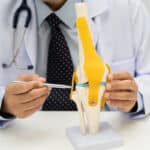
Hamstring strains are painful, unfortunately. They hit athletes like runners, football players and skaters, soccer, and basketball players.
What’s a hamstring? It is not really a single “string.” It is a group of three muscles running along your thigh’s back. You can bend your leg to the knee.
One or more of these muscles get stressed during a hamstring strain. The muscles could even begin to break. The activities that involve running, jumping, or sudden stopping and starting, you may get a strain.
You are more likely to get a hamstring strain if:
-
You don’t warm up before exercise.
-
The thigh muscles or quadriceps are quite tight. It will keep the pelvis forward and make the hamstring tighten.
-
Weak glutes. Glutes and hamstrings work together. Hamstrings can be overloaded and strained when the glutes are weak.
Hamstring Function
-
Decelerate or slow the knee movement while running (straightening).
-
Help extend the hip.
-
Knee bending.
-
Helps rotate the shine in relation to the femur or thigh bone and changes direction.
How Is the Pain
-
Sudden and severe pain in exercise along with the sound of cracking or popping
-
Back pain and lower buttocks as you pace, straighten the knee or lean over.
-
Tenderness
-
Bruising
Factors Influencing Hamstring Strain
Fatigue
Muscles that are weaker are vulnerable. Have you noticed that most hamstring NFL players are the players in the skilled, speed positions? The large receptors, defensive rear, and running rear typically head the list of locations that suffer most from the tightened hamstrings. They run and change directions quickly at every game. When your muscles tire of the hamstring the important role is increased, and the potential for fiber failure increases.
Dehydration
Muscle dehydration in relation to muscle strains is largely overlooked. Simply stated; when forced to contract and relax quickly, the dehydrated muscle becomes less effective. The “drying up” of a muscle can quickly lead to strain at high speeds and/or high-volume activities.
Muscle Imbalance
Strong muscles are very strong. Muscle weakness tends to be longer. When the muscles like the hamstrings, are strong or primary, the less important parts like the hip rotors or lower abs are often too weak. Like a shimmy car, this imbalance becomes worse at high speeds.
Poor Warm-up
Swimming on the outside does not mean that your inside muscles are ready to contract or relax at full throttle. A player who has stood for about 10 minutes and suddenly gets stuck to a special team or a high-intensity exercise risks immediate hamstring damage.
Body Compensation
NFL players are moving very quickly. If the workload on the hamstrings is high, other muscles such as the calves, and glutes need more help.
If your body gets any such problems during a sports activity, contact us today. Oklahoma Spine & Pain Management will help you with sports medicine in OKC.
**Disclaimer: This content should not be considered medical advice and does not imply a doctor-patient relationship.






